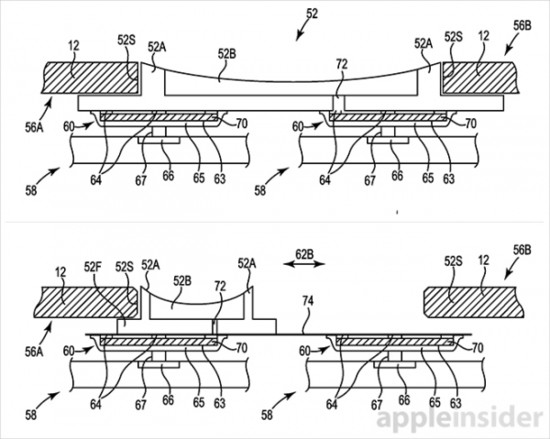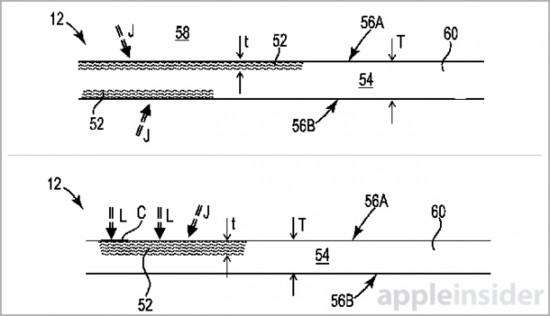A lot of news pointed out that Apple will release an iPhone with a sapphire glass screen this fall. Today, the US Patent and Trademark Office (USPTO) has published three patents filed by Apple, all of which are related to sapphire glass technology, which refers to the technology of using sapphire glass to make iOS device screens and illuminated buttons. The first patent is referred to as "a sapphire glass assembly with residual squeezing force". This patent describes a method of shaping and selectively generating residual squeezing forces in alumina ceramic (sapphire) materials. This method can make the sapphire glass more fragile.
Earlier this month, a video showing the iPhone 6 sapphire glass appeared. Although the iPhone 6 screen material in the video was not confirmed, the test showed that the material could cope with various scratches and withstand extreme bending. These properties are Corning. The orangutan glass does not. The patent mentions that this technique of reinforced sapphire glass is suitable for use on the front or rear casing of the equipment. To improve shock and shock, residual compressive stress techniques can be applied to the outermost layer of sapphire glass.
Residual compressive stresses can be created using any suitable technique, such as heat treatment, tempering, quenching, or other such techniques. Laser heating or boosting can also be used for more precise control. Depending on the sapphire glass mounting equipment, techniques to resist residual compressive stress can be implemented at the edge or center.
Apple's second sapphire-related patent is called the “ceramic insertion control mechanismâ€, which describes the physical control of sapphire materials, such as the Home button and the volume button. The patent describes a sapphire part that operates the drive by pressing, sliding, and manually switching components. These controls can be mounted on the device case or inserted into a sapphire glass screen, such as the iPhone's Home button.
To prevent damage, bearings, insulators or gaskets can be installed around the sapphire parts. These parts may be opaque or of the same refractive index as sapphire. Currently, the sapphire glass material is used on the Touch ID, which protects sensitive circuits inside. Apple mentioned in the patent that the use of LED lighting brings brilliance to the sapphire component.
The third patent is called "Ion Implantation Marker for Screen Protector Glass or Display Components", a technique that creates markers, such as serial numbers or trademarks, on the bottom of a sapphire glass screen. By using ion implantation techniques, the light or chromaticity of the sapphire material is altered in the subsurface, leaving a mark that is both easy to read and capable. Possible ions during use include chromium, titanium, or iron, which are then accelerated in the electric field and injected into the sapphire component. Different ions can be used to create markers of different colors, and some methods may simply change the perceived optical quality of the glass.






Earlier this month, a video showing the iPhone 6 sapphire glass appeared. Although the iPhone 6 screen material in the video was not confirmed, the test showed that the material could cope with various scratches and withstand extreme bending. These properties are Corning. The orangutan glass does not. The patent mentions that this technique of reinforced sapphire glass is suitable for use on the front or rear casing of the equipment. To improve shock and shock, residual compressive stress techniques can be applied to the outermost layer of sapphire glass.
Residual compressive stresses can be created using any suitable technique, such as heat treatment, tempering, quenching, or other such techniques. Laser heating or boosting can also be used for more precise control. Depending on the sapphire glass mounting equipment, techniques to resist residual compressive stress can be implemented at the edge or center.
Apple's second sapphire-related patent is called the “ceramic insertion control mechanismâ€, which describes the physical control of sapphire materials, such as the Home button and the volume button. The patent describes a sapphire part that operates the drive by pressing, sliding, and manually switching components. These controls can be mounted on the device case or inserted into a sapphire glass screen, such as the iPhone's Home button.
To prevent damage, bearings, insulators or gaskets can be installed around the sapphire parts. These parts may be opaque or of the same refractive index as sapphire. Currently, the sapphire glass material is used on the Touch ID, which protects sensitive circuits inside. Apple mentioned in the patent that the use of LED lighting brings brilliance to the sapphire component.
The third patent is called "Ion Implantation Marker for Screen Protector Glass or Display Components", a technique that creates markers, such as serial numbers or trademarks, on the bottom of a sapphire glass screen. By using ion implantation techniques, the light or chromaticity of the sapphire material is altered in the subsurface, leaving a mark that is both easy to read and capable. Possible ions during use include chromium, titanium, or iron, which are then accelerated in the electric field and injected into the sapphire component. Different ions can be used to create markers of different colors, and some methods may simply change the perceived optical quality of the glass.

This Solder Wire is with activated resin flux,It enjoys excellent weld ability,which can be divided into RA and RMA.which is made from extremely high purity raw materials.
Sn63/Pb37,Sn60/Pb40,Sn50/Pb50,Sn45/Pb55,Sn40/Pb60,Sn30/Pb70
Flux-Cored Solder Wire,Solder Welding Wire,Lead Free Solder Wire,Silver Solder Wire
Shaoxing Tianlong Tin Materials Co.,Ltd. , https://www.tianlongspray.com